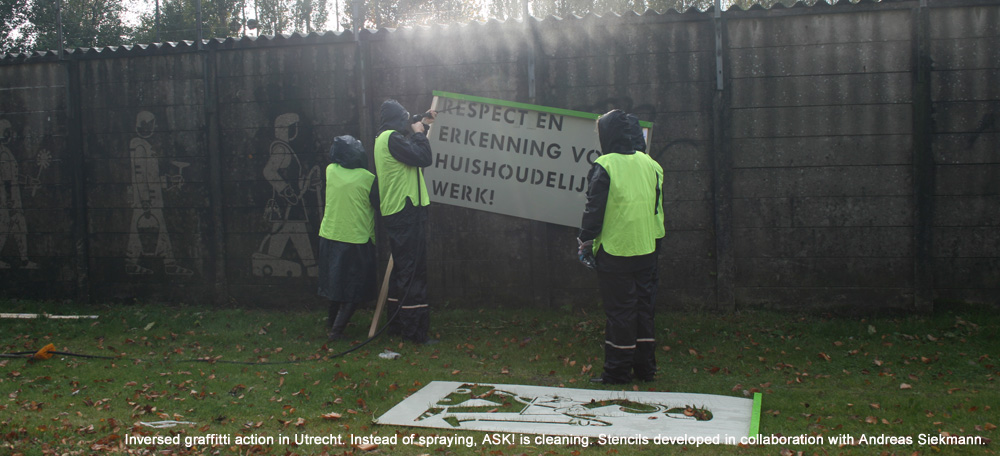“I think the artistic is like a double-edged sword.“
An Interview with Janna Graham, Nicolas Vass, and Annette Krauss by Laila Huber
And to use the example of the “ASK!” solidarity campaign with domestic workers, there is this inverted graffiti: is this an artistic intervention or could this just be an intervention? What is the artistic part when you engage in processes that are outside of the art field? And will you still bring it back to the arts, or is that not important to you?
Annette Krauss: Isn’t it also about the question of where there is a field where you can act? Where can you initiate certain processes? And sometimes it is easier within the arts, and sometimes it doesn’t work at all. The members of Ask! experiment with making visible the conditions and demands of “invisible work” of migrant domestic workers in the Netherlands. At the same time, we try to reflect on our own domestic working conditions asking what are the politics of (in)visibility? Since most of the members are cultural workers, it most definitely is grounded in the “artistic,” but that’s certainly not enough. I think at this specific moment of the ASK! campaign we had the capacity and the possibility to initiate particular actions together with the migrant domestic workers. But, for example, right at the moment the discussions about migrant domestic work happen in the realm of the trade union, I am pretty sure it will move back, then our work can gain meaning and have an impact again, so it kind of goes back and forth, hopefully it works supporting each other.
Janna Graham: The way you presented ASK! I didn’t interpret it as representing artistic work, but rather, as a space where artists and activists learn and unlearn. And yet the work is still aesthetically very powerful. My experience is similar to this, and to what Nico said earlier—that the most potent and aesthetically powerful projects I have been involved with are often the ones that involve people who do not identify as artists working towards social aims. These kinds of interventions that involve artists working with non-artists somehow have more energy and more potency because the analysis that precedes and exceeds the act is much deeper, and that’s why what is produces resonates. You can’t abstract the one from the other, they become something else altogether. For me, using “artistic” is, on the one hand, about provoking routines, because people understand art to be something that is outside of their routines. On the other hand, art has its own routines. It can be extremely divisive in the process of creating something to delineate, something as artistic or saying, “I am the artist and you are not.” It is very different to saying, “We are working towards a social goal or a political goal and we want to be the most powerful we can possibly be with that.” But with these artistic routines come resources: local councils will not give you money to do projects that are critical of the local council’s policy but it may be possible to secure funding for a less defined, longer term project within the realm of art. When you call it artistic it does not always have to adhere to the same kind of instrumentalized outcomes; though sometimes it’s right at the heart of these kinds of instrumentalizations. So it really is a double-edged sword.
Janna Graham, Nicolas Vass, Annette Krauss, Laila Huber ( 2014): “I think the artistic is like a double-edged sword.“. An Interview with Janna Graham, Nicolas Vass, and Annette Krauss by Laila Huber . In: p/art/icipate – Kultur aktiv gestalten # 05 , https://www.p-art-icipate.net/i-think-the-artistic-is-like-a-double-edged-sword/


 Artikel drucken
Artikel drucken Literaturverzeichnis
Literaturverzeichnis